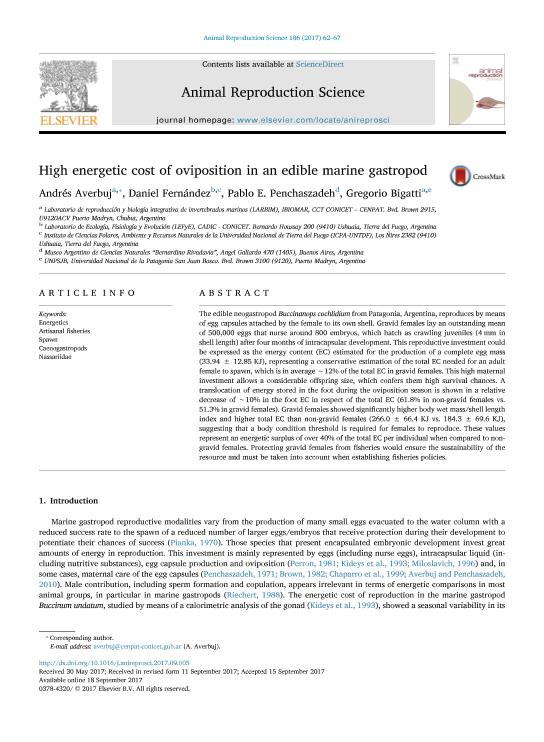Mostrar el registro sencillo del ítem
dc.contributor.author
Averbuj, Andres

dc.contributor.author
Fernandez, Daniel Alfredo

dc.contributor.author
Penchaszadeh, Pablo Enrique

dc.contributor.author
Bigatti, Gregorio

dc.date.available
2018-02-26T21:09:35Z
dc.date.issued
2017-09
dc.identifier.citation
Averbuj, Andres; Fernandez, Daniel Alfredo; Penchaszadeh, Pablo Enrique; Bigatti, Gregorio; High energetic cost of oviposition in an edible marine gastropod; Elsevier Science; Animal Reproduction Science; 186; 9-2017; 62-67
dc.identifier.issn
0378-4320
dc.identifier.uri
http://hdl.handle.net/11336/37180
dc.description.abstract
The edible neogastropod Buccinanops cochlidium from Patagonia, Argentina, reproduces by means of egg capsules attached by the female to its own shell. Gravid females lay an outstanding mean of 500,000 eggs that nurse around 800 embryos, which hatch as crawling juveniles (4 mm in shell length) after four months of intracapsular development. This reproductive investment could be expressed as the energy content (EC) estimated for the production of a complete egg mass (33.94 ± 12.85 KJ), representing a conservative estimation of the total EC needed for an adult female to spawn, which is in average ∼12% of the total EC in gravid females. This high maternal investment allows a considerable offspring size, which confers them high survival chances. A translocation of energy stored in the foot during the oviposition season is shown in a relative decrease of ∼10% in the foot EC in respect of the total EC (61.8% in non-gravid females vs. 51.3% in gravid females). Gravid females showed significantly higher body wet mass/shell length index and higher total EC than non-gravid females (266.0 ± 66.4 KJ vs. 184.3 ± 69.6 KJ), suggesting that a body condition threshold is required for females to reproduce. These values represent an energetic surplus of over 40% of the total EC per individual when compared to non-gravid females. Protecting gravid females from fisheries would ensure the sustainability of the resource and must be taken into account when establishing fisheries policies.
dc.format
application/pdf
dc.language.iso
eng
dc.publisher
Elsevier Science

dc.rights
info:eu-repo/semantics/openAccess
dc.rights.uri
https://creativecommons.org/licenses/by-nc-sa/2.5/ar/
dc.subject
Energetics
dc.subject
Artisanal Fisheries
dc.subject
Spawn
dc.subject
Caenogastropods
dc.subject
Nassariidae
dc.subject.classification
Otras Ciencias Biológicas

dc.subject.classification
Ciencias Biológicas

dc.subject.classification
CIENCIAS NATURALES Y EXACTAS

dc.title
High energetic cost of oviposition in an edible marine gastropod
dc.type
info:eu-repo/semantics/article
dc.type
info:ar-repo/semantics/artículo
dc.type
info:eu-repo/semantics/publishedVersion
dc.date.updated
2018-02-22T14:30:38Z
dc.journal.volume
186
dc.journal.pagination
62-67
dc.journal.pais
Países Bajos

dc.journal.ciudad
Amsterdam
dc.description.fil
Fil: Averbuj, Andres. Consejo Nacional de Investigaciones Científicas y Técnicas. Centro Científico Tecnológico Conicet - Centro Nacional Patagónico. Instituto de Biología de Organismos Marinos; Argentina
dc.description.fil
Fil: Fernandez, Daniel Alfredo. Consejo Nacional de Investigaciones Científicas y Técnicas. Centro Austral de Investigaciones Científicas; Argentina. Universidad Nacional de Tierra del Fuego; Argentina
dc.description.fil
Fil: Penchaszadeh, Pablo Enrique. Consejo Nacional de Investigaciones Científicas y Técnicas. Oficina de Coordinación Administrativa Parque Centenario. Museo Argentino de Ciencias Naturales "Bernardino Rivadavia"; Argentina
dc.description.fil
Fil: Bigatti, Gregorio. Consejo Nacional de Investigaciones Científicas y Técnicas. Centro Científico Tecnológico Conicet - Centro Nacional Patagónico. Instituto de Biología de Organismos Marinos; Argentina. Universidad Nacional de la Patagonia; Argentina
dc.journal.title
Animal Reproduction Science

dc.relation.alternativeid
info:eu-repo/semantics/altIdentifier/url/http://linkinghub.elsevier.com/retrieve/pii/S0378432017304049
dc.relation.alternativeid
info:eu-repo/semantics/altIdentifier/doi/http://dx.doi.org/10.1016/j.anireprosci.2017.09.005
Archivos asociados
